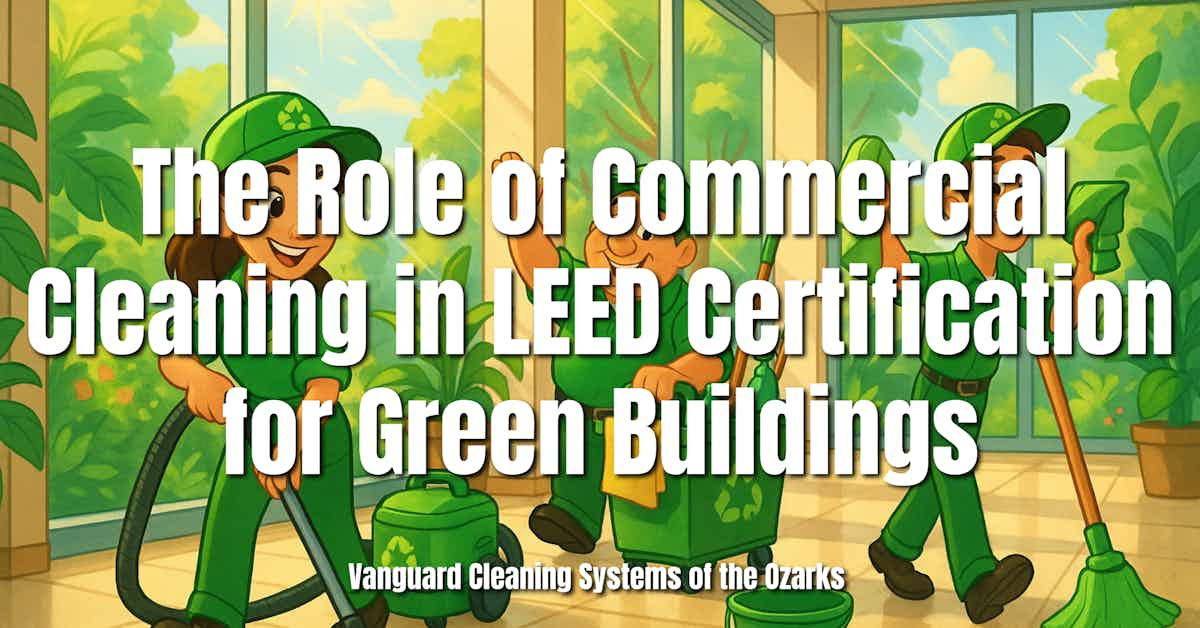Sustainable buildings don’t just earn LEED certification—they keep it alive through the daily, measurable impact of green commercial cleaning.

The Strategic Role of Commercial Cleaning in Achieving and Sustaining LEED Certification
Commercial cleaning plays a direct and measurable role in both achieving and maintaining LEED (Leadership in Energy and Environmental Design) certification for green buildings. While many organizations focus on sustainable design and construction to secure certification, the LEED framework—especially in the LEED for Existing Buildings: Operations & Maintenance (LEED-EBOM) rating system—places significant emphasis on ongoing operational practices. Green cleaning policies, sustainable products, and environmentally responsible procedures can influence multiple credit categories, particularly those related to Indoor Environmental Quality (IEQ), occupant health, and long-term building performance.
By integrating certified green cleaning programs, building owners can meet mandatory LEED prerequisites, earn additional credits, and position their facilities for successful recertification. These operational measures also deliver tangible benefits beyond certification, such as improved tenant satisfaction, reduced maintenance costs, and enhanced indoor environmental quality. For facilities managers, commercial cleaning is not a peripheral service—it is a strategic, point-generating component of a building’s sustainability plan that directly supports both environmental goals and market competitiveness.
How Commercial Cleaning Contributes to LEED Certification Credits
Commercial cleaning intersects with multiple LEED credit categories, making it a key operational driver for certification. In LEED-EBOM, green cleaning is not optional—buildings must implement a documented green cleaning policy that aligns with recognized environmental standards. This policy serves as the foundation for earning additional points across related performance areas.
Green cleaning contributes most directly to Indoor Environmental Quality (IEQ) credits. Using certified low-toxicity cleaning products reduces volatile organic compound (VOC) emissions, improving air quality and minimizing health risks for occupants. High-efficiency cleaning equipment, such as CRI-approved vacuums and low-noise scrubbers, supports both occupant comfort and the LEED requirement for reduced environmental impact.
Beyond IEQ, green cleaning can indirectly support other credit areas. For example, maintaining clean HVAC components can sustain system efficiency, contributing to ongoing energy performance. Proper waste handling and recycling within the cleaning program can help secure points in the Materials and Resources (MR) category. Consistent documentation of cleaning schedules, product inventories, and staff training can also be leveraged during LEED audits, ensuring verifiable compliance with credit requirements.
For building owners and facility managers, aligning cleaning practices with LEED standards creates a dual benefit: points toward certification and operational improvements that protect the asset’s value.
Operational Best Practices for LEED-Aligned Commercial Cleaning
To maximize the impact of commercial cleaning on LEED certification, facilities managers must adopt practices that are both environmentally responsible and fully documented. The following operational strategies align with LEED prerequisites and credit requirements while ensuring measurable, ongoing performance benefits.
- Implement a Certified Green Cleaning Policy
Establish a written policy based on recognized standards such as Green Seal GS-42 or ISSA CIMS-GB. This should outline product criteria, approved equipment, and cleaning protocols designed to protect occupant health and the environment. - Use Environmentally Preferable Products
Select cleaning agents with third-party certifications, low VOC content, and biodegradable formulations. Maintain an inventory log to verify compliance during LEED audits. - Invest in High-Efficiency Equipment
Utilize vacuums, extractors, and floor machines that meet LEED noise and filtration standards. Regularly service equipment to maintain optimal performance and energy efficiency. - Train and Certify Cleaning Staff
Provide ongoing education in safe chemical handling, equipment use, and sustainable cleaning methods. Document training sessions to support credit documentation. - Monitor and Evaluate Custodial Effectiveness
Use inspection checklists and building walkthroughs to assess cleaning outcomes and identify areas for improvement. Incorporate these evaluations into LEED performance reports. - Integrate Waste Management and Recycling
Coordinate with custodial teams to ensure proper sorting, collection, and disposal of recyclables and waste, contributing to LEED Materials and Resources credits.
Following these best practices not only secures valuable LEED points but also ensures the cleaning program actively supports occupant health, operational efficiency, and long-term building sustainability.
Long-Term Benefits of LEED-Compliant Commercial Cleaning
A well-executed commercial cleaning program that meets LEED standards delivers value far beyond the certification plaque on the wall. Over time, the consistent use of environmentally preferable products, high-performance equipment, and documented cleaning protocols translates into measurable health, operational, and financial advantages.
From a health perspective, maintaining superior indoor environmental quality reduces occupant exposure to allergens, particulates, and harmful chemicals. This can lead to fewer sick days, higher workplace satisfaction, and improved tenant retention—factors that enhance a building’s marketability.
Operationally, LEED-compliant cleaning helps extend the lifespan of building materials and systems. Clean HVAC coils, carpets, and flooring reduce strain on mechanical systems and minimize the frequency of costly replacements. Routine documentation also ensures readiness for LEED recertification, avoiding the resource-intensive scramble that can occur without consistent record-keeping.
Financially, a proven green cleaning program supports competitive positioning in the real estate market. Properties that can demonstrate verifiable operational sustainability may command higher rental rates and retain tenants longer, while also qualifying for tax incentives or sustainability grants in some jurisdictions.
By embedding LEED-compliant cleaning into ongoing operations, building owners and managers safeguard both certification status and long-term asset value—making it an investment with returns that compound over time.
Integrating Commercial Cleaning into LEED Recertification Strategies
For buildings certified under LEED, maintaining status is not a one-time effort—recertification requires proof that sustainable operations are ongoing. Commercial cleaning is one of the few daily activities that can continuously generate compliance data, making it a cornerstone of a successful recertification plan.
A structured green cleaning program supports recertification by providing verifiable documentation. Product purchase records, equipment maintenance logs, and staff training certificates all serve as evidence that LEED-aligned practices are being upheld. Integrating these records into a central sustainability management system ensures quick access during performance reviews or audits.
Cleaning teams can also play a proactive role in spotting operational inefficiencies that may affect recertification. Regular inspections often reveal early signs of HVAC inefficiency, water intrusion, or material wear—issues that can be addressed before they impact indoor environmental quality scores.
Periodic third-party assessments of custodial practices add credibility and can highlight opportunities to improve point performance in categories like Indoor Environmental Quality and Materials and Resources. By embedding cleaning operations into the broader sustainability strategy, facilities managers create a continuous feedback loop that keeps buildings on track for recertification while optimizing health, performance, and environmental impact.
Action Steps for Facility Managers to Align Cleaning with LEED Goals
Facility managers looking to maximize the role of commercial cleaning in LEED certification should focus on building a structured, measurable program that aligns daily operations with LEED credit requirements. The following action steps provide a framework for immediate and long-term impact:
- Conduct a Green Cleaning Audit
Assess current cleaning products, equipment, and procedures against LEED standards to identify gaps. Document findings and set measurable improvement targets. - Select LEED-Compliant Vendors
Partner with cleaning contractors certified in sustainable practices, such as ISSA CIMS-GB or Green Seal GS-42. Include LEED-related performance requirements in service contracts. - Establish Clear Documentation Protocols
Implement systems to track product purchases, staff training, and custodial performance metrics. These records serve as evidence for credit achievement and recertification. - Integrate Cleaning into Sustainability Committees
Include custodial leadership in sustainability planning meetings to ensure cleaning operations directly support LEED performance objectives. - Schedule Regular Performance Reviews
Evaluate the program’s effectiveness quarterly, adjusting policies and procedures based on LEED updates, audit feedback, or operational changes. - Engage Occupants in Cleaning Awareness
Educate building occupants on waste sorting, recycling, and responsible space usage to enhance cleaning efficiency and support LEED-related initiatives.
By embedding these steps into the facility’s operational plan, commercial cleaning becomes a consistent contributor to LEED point accumulation, recertification readiness, and overall building performance.
FAQ: The Role of Commercial Cleaning in LEED Certification
What is the role of commercial cleaning in LEED certification?
Commercial cleaning supports LEED certification by improving Indoor Environmental Quality, using eco-friendly products, and implementing sustainable procedures that meet LEED prerequisites and credit requirements.
Can green cleaning help earn LEED points?
Yes. LEED awards points for certified green cleaning programs, low-VOC products, high-efficiency equipment, and documented custodial effectiveness.
Does LEED require a green cleaning policy?
In the LEED for Existing Buildings: Operations & Maintenance (LEED-EBOM) system, a green cleaning policy is a prerequisite for certification.
How does cleaning affect LEED recertification?
Ongoing green cleaning practices provide verifiable documentation that helps maintain and renew LEED certification during recertification cycles.
What are examples of LEED-compliant cleaning products?
LEED-compliant products include those certified by Green Seal, EcoLogo, or EPA Safer Choice, all with low environmental and health impacts.
How can facility managers align cleaning with LEED goals?
Facility managers can conduct audits, select certified vendors, train staff in sustainable methods, and track cleaning performance for LEED compliance.
References
- Golbazi, M., & Aktas, C. (2020). LEED CERTIFICATION AND PATIENT WELLBEING IN GREEN HEALTHCARE FACILITIES. Journal of Green Building. https://doi.org/10.3992/jgb.15.4.3
- Kim, J., Son, K., & Son, S. (2020). GREEN BENEFITS ON EDUCATIONAL BUILDINGS ACCORDING TO THE LEED CERTIFICATION. International Journal of Strategic Property Management, 24, 83-89. https://doi.org/10.3846/ijspm.2020.11097.
- Devine, A., & Kok, N. (2015). Green Certification and Building Performance: Implications for Tangibles and Intangibles. The Journal of Portfolio Management, 41, 151 - 163. https://doi.org/10.3905/jpm.2015.41.6.151.
- Newsham, G., Mancini, S., & Birt, B. (2009). Do LEED-certified buildings save energy ?. https://immobilierdurable.eu/images/2128_uploads/Leed_and_energy_CNRC.pdf
- Blumberg, D. (2013). LEED in the U.S. Commercial Office Market: Market Effects and the Emergence of LEED for Existing Buildings. http://dx.doi.org/10.1080/10835547.2012.12091839.
Conclusion: Positioning Commercial Cleaning as a LEED Performance Driver
Commercial cleaning is more than a routine maintenance function—it is a measurable, strategic contributor to LEED certification success. By aligning cleaning practices with LEED standards, facility managers can directly impact credit achievement in categories such as Indoor Environmental Quality, Materials and Resources, and overall operational performance.
Green cleaning programs provide ongoing proof of sustainable operations, supporting both initial certification and recertification cycles. The consistent use of environmentally preferable products, high-performance equipment, and well-trained staff not only safeguards compliance but also improves occupant health, reduces operational costs, and enhances market value.
In an increasingly competitive real estate market, buildings that can demonstrate both certified sustainability and documented operational excellence are better positioned to attract and retain tenants. Treating commercial cleaning as a core component of the building’s LEED strategy ensures that environmental performance goals are met, health and safety standards are upheld, and the asset’s long-term value is protected.
Vanguard Cleaning Systems of the Ozarks' franchise-owned custodial service provider business cleans more than 8M sq. ft. weekly, maintaining an industry-topping 95+% of its customer base, year-over-year, and boasting more than 60 5-star Google reviews.
Need more capability from your vendor partners? --Let's talk.
In Oklahoma, dial 918-960-4450
In Arkansas, dial 479-717-2410
In Missouri, dial 417-812-9777

